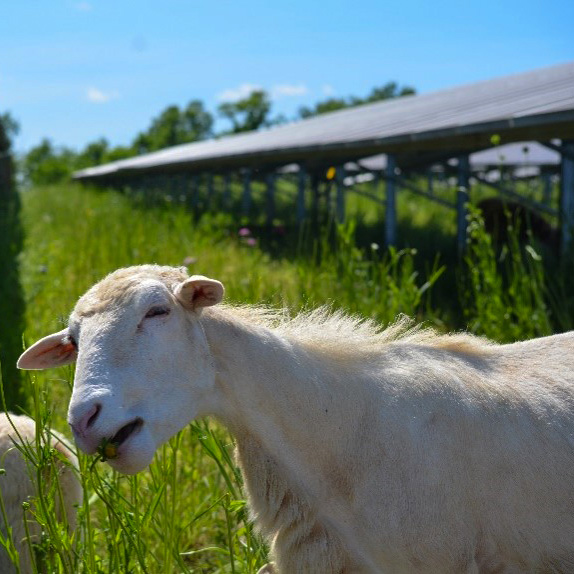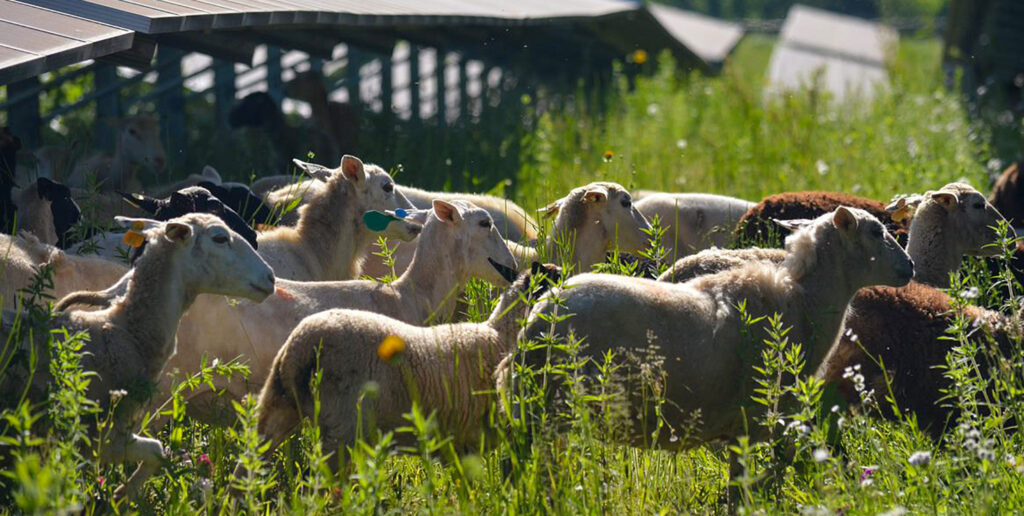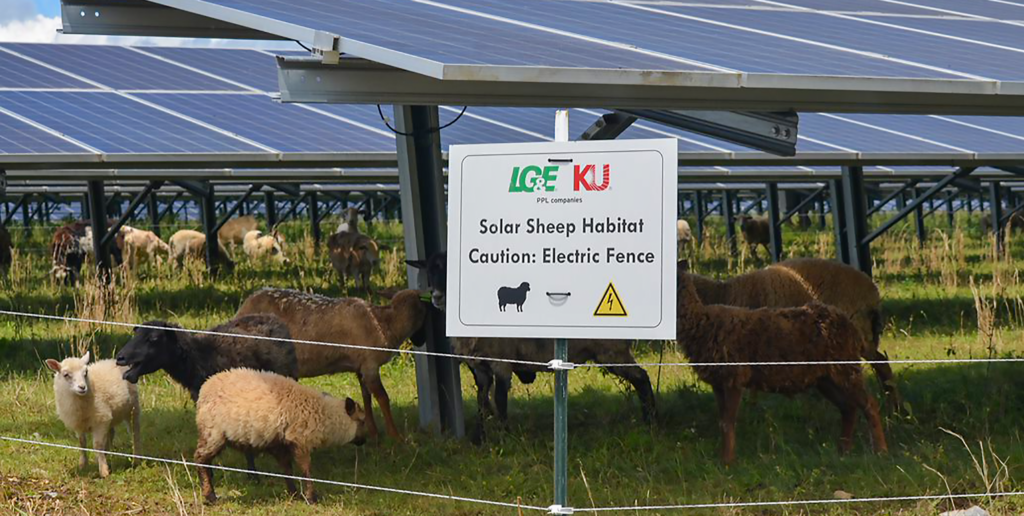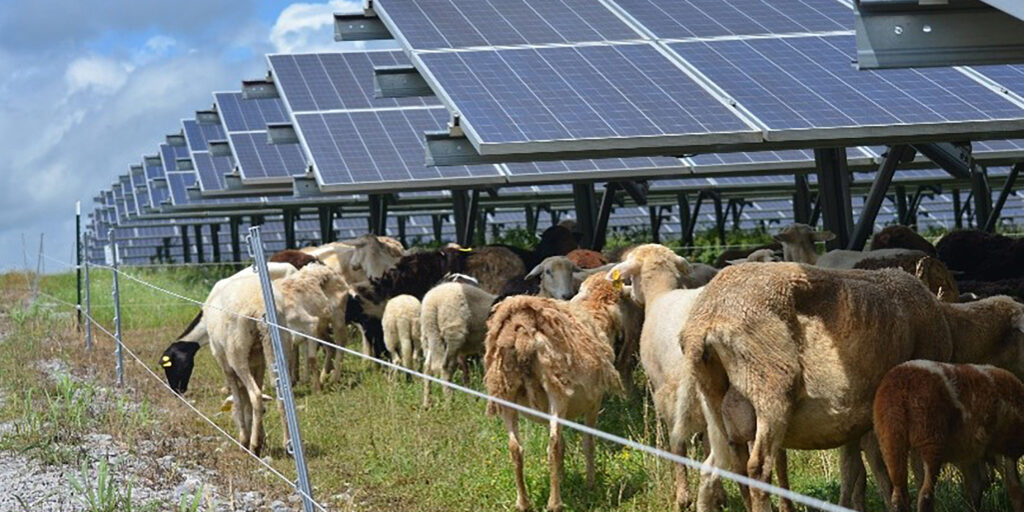How grazing sheep can reduce vegetation management costs and bolster community support for solar projects
Over the past decade and a half, Aron Patrick has had a singular career focus: to expand the deployment of solar and other renewable energy generation. For nearly seven years, Patrick worked as assistant director and manager of renewable energy in Kentucky’s Department of Energy. He then held various positions at the utility Louisville Gas & Electric and Kentucky Utilities (LG&E-KU) for nearly seven years before joining PPL Corporation, LG&E-KU’s parent company, as director of research and development in the summer of 2022.
Patrick’s wide-ranging experience deploying solar projects has taught him a lot about the barriers that need to be overcome to get more solar projects built. “Right now, the greatest single challenge we have to expanding solar generation in Kentucky is the problem of more land,” Patrick said. “There are local communities that are opposed to using land for renewable energy.”
In some cases, the opposition is the result of past solar projects that have had a negative impact on local ecosystems. For instance, Patrick has seen instances when developers have cut down forestland for a solar site and then laid down gravel and sprayed chemicals to reduce the need for vegetation management.
From a purely financial perspective, there is a rationale for this approach. Vegetation management is a significant operations and maintenance (O&M) expense. But solar and other renewable energy projects in Kentucky and around the country need community support to get built.
“At a minimum, these projects need to integrate with the natural environment and leave it no worse than it was before,” Patrick said. “But what we really need to do is integrate these solar sites so that they improve the ecosystem and fit into the agricultural heritage our ratepayers expect. It’s taking a solar farm from being potentially harmful to the environment to something that is beneficial and beautiful to look at.”
A Grazing Solution?
In Kentucky and around the globe, an emerging answer to both address community concerns and reduce vegetation management costs has four legs and eats all day: sheep. While still at LG&E-KU, Patrick collaborated with EPRI to develop and implement a plan for sheep to graze 10 acres of a 50-acre solar farm in Mercer County, Kentucky. The demonstration project began in 2020, and a detailed description of the grazing plan and results can be found in the EPRI report, Solar Grazing: Viability of Grazing Sheep for Vegetation Management, Year 2.
For Patrick, the potential to reduce O&M expenses was made clear on a visit to a solar farm. “I was out at a site and noticed we had 30-plus people weeding underneath the panels,” Patrick said. “This was labor-intensive and also a safety issue because you have low-trained workers on the property who could potentially weed eat a wire.” LG&E-KU estimated the cost for the traditional mowing and weed eating to manage 10 acres of the solar farm was $14,000 in 2020.
While containing costs is important, the potential benefits of using sheep for vegetation management also include an improved local ecosystem. For example, a well-designed seeding and grazing plan for sheep will prevent most vegetation from growing taller than the panels and negatively impacting energy production. A sustainable grazing plan can also reduce water runoff, improve water and soil quality, and enhance regional biodiversity.
But all those potential benefits hinge on sheep being a practical solution for vegetation management. And that’s what LG&E-KU and EPRI set out to learn in the demonstration project.
“We were worried about the safety and welfare of the animals,” Patrick said. “We had accounting questions and legal questions. Are sheep a capital or O&M expense? We also had questions about whether the sheep would get away. I think people imagined this chaotic environment of sheep running around and our staff chasing them.”
Choosing Sheep and Creating a Grazing Plan
To begin answering these questions, a selection of Shetland and Katahdin sheep were brought to the solar site from nearby Shaker Village—a local non-profit that preserves the architecture and ways of the Shakers who moved to the area in the 1800s—to graze from the early spring to late fall of both 2020 and 2021. The breeds of sheep were selected because they were believed to be least likely to damage the solar panels and equipment.
One reason that is the case is that Shetland sheep are relatively small, which is an advantage in reaching vegetation growing under and around panels as low as 36 inches off the ground. The breed’s small stature enables the animals to navigate around the panels and equipment without getting caught up in wires and other infrastructure. Larger Katahdin sheep were added later to help manage taller vegetation, like the invasive species Johnson grass.
The grazing plan developed for LG&E-KU by Shaker Village evaluated the optimal number of sheep to use and how often to rotate the animals on and off the land. Typically, a 10-acre pasture where sheep don’t rotate would require about 20 animals. In this case, though, it was a priority to keep vegetation from growing taller than the lower edge of the panels to prevent panel shading and use rotational grazing. Rotational grazing is a type of regenerative grazing that provides a range of ecological benefits, from improving soil health to reducing soil erosion. It’s also important to note that the intention was always to evolve and change the original grazing plan based on environmental conditions. Flexibility in devising and adapting the grazing plan promotes the health of the sheep while meeting the solar site’s vegetation management goals.
With that in mind, LG&E-KU installed nine one-acre paddocks that 25 sheep would rotate through. Another element of the grazing plan was determining how long sheep would graze in a paddock before allowing the vegetation to regenerate. This matters both for the sheep and the plants. Short grazing intervals followed by a restoration period allows the plants to keep growing and ensures that animals benefit from more palatable and nutritious vegetation. The grazing plan initially included five days of grazing followed by 45 days of recovery, which is the same approach used in the Shaker Village’s pastures.
Lessons Learned Lead to Changes
After the first grazing season, LG&E-KU and EPRI made several adjustments for 2021. The grazing plan was also adjusted to move away from a uniform five days of grazing followed by 45 days of regeneration. This was done better to match the natural seasonal variation in vegetation growth.
For example, cooler early spring temperatures mean plants grow slower, and fewer sheep are needed to control vegetation. As temperatures and vegetation growth rates increased, more sheep were grazed. For example, 18 sheep grazed for seven days in the early spring, followed by 63 days of recovery. From late spring through the summer, 51 sheep grazed for three days, followed by 27 days of recovery.
According to Dr. Ashley Bennett, an environmental research scientist at EPRI, who worked closely with LG&E-KU to implement the demonstration project, one takeaway from the first two years of grazing was basic but important. Sheep can be an effective vegetation management solution.
Not only were concerns that sheep would cause chaos and damage equipment unfounded, the animals reduced the utility’s vegetation management costs. Indeed, the cost to use sheep in the project’s first year was about $11,500, compared to $14,000 using mowers and weed eaters. In the project’s second year, vegetation management costs were reduced to about $9,000 thanks to an improved grazing plan.
A National Solution for Better Vegetation Management and Community Support?
LG&E-KU participated in the demonstration project because it wanted to serve as a model for other utilities considering grazing as a vegetation management solution. An upcoming EPRI report, Evaluating opportunities for sheep grazing at utility-scale solar farms in the United States: A Review, is expected to be published in 2023 and chronicles the challenges, opportunities, and practical application of agrivoltaics, specifically grazing, around the nation.
Agrivoltaics refers to the dual use of land for solar energy and agricultural production. Besides grazing livestock to manage vegetation, agrivoltaics can also include habitat conservation, especially for pollinators, as well as crop production in and around solar projects. Utilizing solar sites for multiple uses can bolster community support.
“From the landowner and community standpoint, land stewardship is a favorable aspect of agrivoltaics,” said Terry Jennings, an EPRI principal project manager whose research focuses on advancing economically and environmentally responsible renewable energy development. “Local communities may be more supportive if they perceive the solar operator and landowner as good stewards of the land. Another aspect is continued agricultural usage that helps to maintain the agricultural heritage of a site or community.”
Agrivoltaic applications like solar grazing are gaining interest and deployment. For example, the American Solar Grazing Association (AGSA) was founded in 2019 and had over 500 members by 2022. AGSA estimates that 15,000 acres of solar installations representing 2,500 megawatts are currently using animals to control vegetation.
But there are still challenges, including variable and uncertain costs. Solar developers are incentivized to build their projects as quickly, cheaply, and profitably as possible. Utilities are keen to reduce O&M costs but also are motivated by sustainability. “Many of our utilities are very interested in conservation and how solar sites can provide environmental benefits,” Bennett said. “But the utilities also must have a business case to make changes, such as using a native seed mix to support pollinators instead of a non-native turf grass mix. They need to show modifications to current practices will not increase their costs and will provide ecological benefits.”
Barriers to Implementation and More Research Needed
While there is genuine interest in solar grazing, EPRI’s report also identified several barriers and areas that require additional research. Perhaps the most significant obstacle is an insufficient number of sheep and shepherds. Already, there are not enough sheep to graze the solar plants in operation across the U.S., let alone to manage vegetation at the many solar sites that will be built in the future.
Another barrier to more widespread solar grazing is the need for additional infrastructure at solar plants, including water for sheep to drink. Strong communication between solar power plant owners, operators, and sheep grazers is also important to develop and evolve grazing plans. It’s also true that not all solar sites will be suitable for sheep grazing.
EPRI’s report also notes that grazing sheep to manage vegetation at solar plants is still in its infancy, and much more needs to be learned. For example, more experience is needed to develop guidelines and best practices for successfully using sheep in vegetation management across different geographies and ecosystems. This includes learning how to combine pollinator habitat and grazing on the same site to integrate multiple ecological benefits. For now, the optimal approach for utilities and developers considering solar grazing is to work with experts to develop a grazing plan and to pilot it on a small parcel of land to test whether it can work and is cost-effective.
The Importance of Patience
At LG&E-KU, the initial experience of using sheep for vegetation management has been successful enough to expand the practice to a second, much larger solar farm near Harrodsburg, Kentucky. “We’re planning ten 1,500-acre solar farms in the next few years, and there’s no question moving forward how we are going to manage the land at our solar sites,” Patrick said. “I can’t imagine a situation where you wouldn’t want sheep in some way.”
But Patrick is also quick to point out that the utility’s approach is evolving with the lessons it’s learning. For example, LG&E-KU has even lowered its vegetation management costs by embracing technology—like motion detectors and security cameras—to monitor sheep. This has reduced the need for shepherds always to be on-site, a significant cost savings because labor is the largest expense of using sheep for vegetation management.
Patrick says another big lesson for anyone thinking about solar grazing is to understand it takes time. “This is not something where you can have one employee get it done quickly and expect it all done in a month,” Patrick said. “We spent about a year planning and then two years in site prep. But that time is well spent when you see how beautiful these sites can be and how much they benefit local communities.”
EPRI Technical Expert:
Ashley Bennett
For more information, contact techexpert@eprijournal.com.





